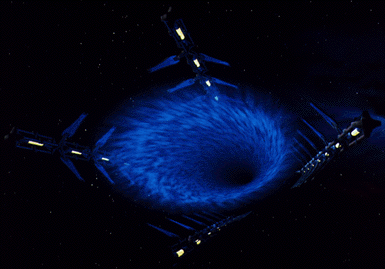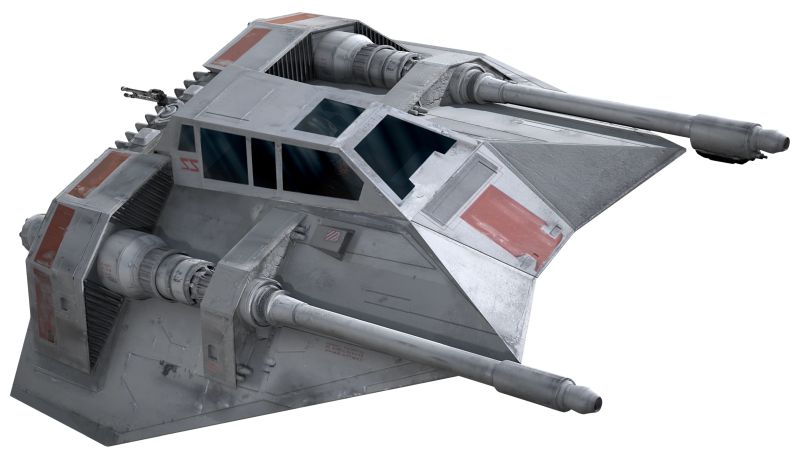 HYPERSPACE JUMPGATE
Model: Hyperspace Jumpgate
Type: stationary Hyperspace entry/exit travel device
Scale: Capital
Skill: Jumpgate operations (can sub for Capital ship piloting)
Crew: 1 (usually stationed elsewhere)
Cost: Not available for sale*
Maneuverability: 1D
Speed: 1
Hull: 10D (per section)
Availability: 1, R
GAME NOTES:
-COST: Though the "Cost" section says not available for sale, hyperspace jumpgates can be bought and sold. This listing is because, more than likley, jumpgates will often either not be available for sale to private citizens, or they will cost so much that a private citizen may have better luck purchasing a fleet of capital ships. This is because of the importance of jumpgates to galactic commerce and the amount of profit that can be gained by controlling them and the trade traffic constantly going through them, as well as controlling the area of space a jumpgate is stationed in. The buy and sale of jumpgates may be more in the realm of high corporate, international and interplanitary politics and negotiation than that of someone simply coming up with the money to buy one for themselves. Buying a ship with its own jumpgate engine is much more doable.
-OPERATIONS: There are many differences between using a jumpgate and using the jump-point engines of a ship. Firstly, the jump engines of a ship often put certain limitations on the ship, such as drawing so much power to form a jump-point that the ship can do nothing else in that round like maneuver or use weapons. Ships must then maneuver into the gate the next round, which can leave them vulnerable to being damaged, or worse, an attack that could destabilise their jump-point and destroy them. Furthermore, after using their jump engines, most ships must then recharge these engines, which can often take a minute or two (10 to 20 rounds!). Later, more advanced ships do not have such limitations after acquiring Vorlon technology, though this is restricted to certain governemnts like the Minbari, Earth Alliance and the Interstellar Alliance, and only for military ships. When using a hyperspace jumpgate, these issues do not occur. Stationary jumpgates are always powered up and ready for use, can be activated by the controller at any time, and ships traveling through these gates do not need to worry about recharging their power reserves or not being able to use weapons (though the gate itself could still be attacked and made to collapse).
-SKILLS: Hyperspace jumpgates have "Jumpgate Operations" listed as their skill for use. This is due to jumpgates having several uses that set them apart from other ships or space stations. If GMs/players wish, other more common skills can be substituted for operating jumpgates, such as Space Station Operations, Capital Ship Piloting (as capital ships often have their own jump engines), or even Sensors or Communications. GMs/players could even allow all of these skills to be allowed, with any skill not Jumpgate Operations being used at a penatlty of -1D or so.
-JUMPGATE EXPLOSION: If a hyperspace jumpgate is ever destroyed, the resulting explosion will be massive and widespread. Damage and Space Range increments for explosiuon will vary depending on circumstances (inactive, active, and opening a jump-point within a jump-point). Damage may also include ion weapon damage effects due to the amount of discharged energy being released.
--Powered Down: No explosion.
--Inactive But Powered Up: Damage 10D/8D/6D/4D, Range 1/2/3/4.
--Active Jump-Point Opened: Damage 14D/12D/10D/8D, Range 2/4/6/8.
--Jump-Point In A Jump-Point: Damage 20D/15D/10D/5D, Range 3/6/9/12
[NOTE: Only a White Star on full burn has ever been known to outrun a jumpgate explosion caused by a jump-point being opened within the jumpgate itself, and even then it caught some damage from the explosion. Check the White Star's Gravimetric Drive to see how this might be possible.]
DESCRIPTION:
Jumpgates are large spacebourne structures made up of three or four separate but aligned struts that generate a spatial vortex, or Jump point into Hyperspace allowing any ship to travel interstellar distances.
Technology
Jumpgates work by manipulating four stable, energetic forces of opposing polarity generated by each strut that work against each other to create a vacuum effect which forms an unstable vortex which rips the spacetime continuum and opens a pathway to hyperspace via a singularity. Some jumpgates use three struts instead of four, though the principle is essentially the same.
The struts themselves are each comprised of seven field phasing modules and twelve paired spatial constriction arrays and are assembled in modular sections with Quantium 40 acting as a vital construction material.
Though relatively stable devices, jumpgates, especially ancient ones have been known to be faulty on occasion. Usually this only means a bumpier than usual transition across the event horizon but anything that disturbs the opposing gravitational forces between the struts can cause a reverberating shock-wave that collapses the jump point, essentially forcing the gate closed. If a gate closes prematurely or incorrectly, the resulting explosion and release of energy rivals that of an exploding planetary body, with a blast wave that only the very fastest ships have a hope of escaping in one piece.
Jumpgates require an enormous amount of power and cannot simply be shut down to prevent intruders. In fact it takes at least two days to safely power down a gate and another four or five to power up again. To attempt otherwise would result in a massive explosion of energy, destroying the gate and anything else in range.
History
It is unknown exactly which race invented the technology as nothing of the original jumpgate builders has ever been found and all that can be determined by examining the gates themselves is that the aliens had been highly advanced, and extraordinary engineers. The first gates may have been built as early as 4700 B.C. (seven thousand years before the Third Age), and had apparently spread across interstellar space as a flourishing civilization for some four to five thousand years hence. After that they seem to have completely vanished, leaving behind no trace of their civilization, other than the gates themselves.
Some of the younger alien races such as the Minbari and the Centauri discovered the gates while exploring the outer edges of their own solar systems in their early, primitive sub-light ships. Once they had unlocked the complex codes required to activate the jump gate sequence, they began to explore hyperspace in an attempt to map the jumpgate network. However, as later generations know all too well, hyperspace travel is extremely hazardous and many ships were destroyed or simply lost forever. The ones that made it back into normal space had found out the hard way just how perilous hyperspace navigation was and as a result a series of tachyon beacons were established to help ships locate and activate the gates within the chaotic nightmare of hyperspace.
Exactly how the original alien builders had navigated through their own network of gates isn't known, but they didn’t seem to use any recognizable beacons. For this reason, the discovery of an original gate is rare as they have so far only been stumbled upon through sheer blind luck and without any dependable means of detecting one at long range, finding them all could take millennia, if at all possible.
After it was determined how to open a gate, the next step was to determine how they worked so the technology could be duplicated and new gates be built. This required large amounts of Quantium 40 a rare radioactive material that due to its essential nature in jumpgate construction has become the most valuable substance in the galaxy. Since not all inhabited systems had an ancient gate of their own, some races such as the Centauri saw an opportunity for business and profit by seeking out isolated worlds and selling or renting access to their own gate network to trade with other worlds, or if the area was of sufficient value to annex the territory and conquer any inhabited world, as they did Narn. Earth was one of the former, having no military or strategic value the Centauri eagerly sold the Earth Alliance time on their own jumpgates to allow trade with other worlds, though before long humanity figured out how to construct their own gates and ships with jump-point generators, eventually joining the interstellar community as equal participants. The Sol System's gate was originally built in Earth orbit but was later moved to what became known as the Transfer point off Io, amid security concerns that an invading force could arrive practically on Earth's doorstep with little warning. In its new location it was several days journey from humanity's population centres on Earth and the then small colony on Mars. In addition, the natural radiation belt around Jupiter offered the gate sufficient protection from long range targeting.
Jumpgate Use
Jumpgates are at the center of interstellar commerce and trade. Recording the signature of every ship that passes through, they allow the race that currently controls said gate to toll the travelers for its use and services, which are usually something arranged between governments by treaty. These treaties set tolling rates and rights to use certain trade routes, in exchange for the security codes necessary for opening the gates.
The gates also feature beacons that guide ships in hyperspace to a safe exit point. Even ships equipped with jump engines often use jumpgates in order to save energy, and are often required to do so as a matter of book-keeping to log their travels. It is also possible to enlarge the size of a jump point simply by moving the struts further apart, though it's not known what the upper limit of this capability is as it most likely requires an increasing amount of energy the larger the vortex becomes.
The destruction of jumpgates in interstellar combat is considered a violation of the accepted rules of civilized warfare, as it jeopardizes the entire beacon system and is ultimately self-defeating as all races use and need the jumpgate network. Whoever may win or lose a conflict, the network must go on.
Although destroying jumpgates is generally frowned upon during a war, it is common practice in wartime for belligerent powers to program their jump gates to deny access to certain frequencies, thus preventing an enemy from using friendly gates and forcing them to open their own jump points. This was done by Earth during the Minbari War, though given the degree of Minbari technical superiority, it offered little in the way of a tactical advantage.
Some gates, particularly those built by surveyor corporations, utilize encrypted beacons that make it impossible for someone without the correct cipher to determine the gate's location in normal space.
New gates are being constructed all the time by various worlds, depending on the availability of Quantium-40. Opening up access to new, previously inaccessible areas of space, most are constructed for the purpose of finding yet more sources of Quantium-40 to build or repair even more gates. Occasionally long- range probes discover "new" ancient gates, and most still function despite being many thousands of years old. However, some of the older ones have proven to be a little bit "quirky", which can result in a somewhat rough transition in and out of normal space for the ship using them.
Bonehead Maneuver
Such is the nature of jump point physics and the energy involved with creating them that if one attempts to use a jump-drive to open a jump point within an already active jumpgate vortex, then the massive release of energy would destroy the gate and most likely the ship that opened the point as well. Earth experimented with this tactic during the Earth-Minbari War, though it quickly became known as the "Bonehead Maneuver" as no Earthforce ship was fast enough to open the point and clear the blast radius before being destroyed. In 2260 the White Star 1 became the first and only known ship to survive this maneuver when it was used to destroy a pursuing Shadow Vessel at the Septis jumpgate in Sector 47.
Notes
Though never directly addressed, it's possible that the original builders of the jumpgate network may have been the Vorlons, as among all the other First Ones they are the only ones to have used jumpgates and the type of Jump points used by the younger races. All the other first ones use their own distinct method of entering and leaving hyperspace; the Shadows seem to phase in and out of hyperspace, the Walkers of Sigma-957 use what looks like a very large vortex of crackling energy while the others use a variety of singularities and phasing methods.
The Vorlons have been know to have constructed at least one type of gate, that being the Thirdspace Gate, built and jettisoned into hyperspace some one million years ago.
It was later revealed in Babylon 5 The Lost Tales that the Vorlons had created Quantum Space technology. Quantum Space is yet another dimension that ships can fly through to achieve interstellar travel distances. The key difference is that Quantum Space allows travel at about twice the speed that of hyperspace. It also has a somewhat more difficult transition for people entering or leaving Quantum Space, mostly uncomfortable disorientation. It has also been revealed over time that since the First Ones left the galaxy for beyond the rim, the Vorlons had left many technologies behind that were discovered by the Interstellar Alliance, who began using these to their advantage. Why the Vorlons had something like Quantum Space technology and never used it is unknown.
|












